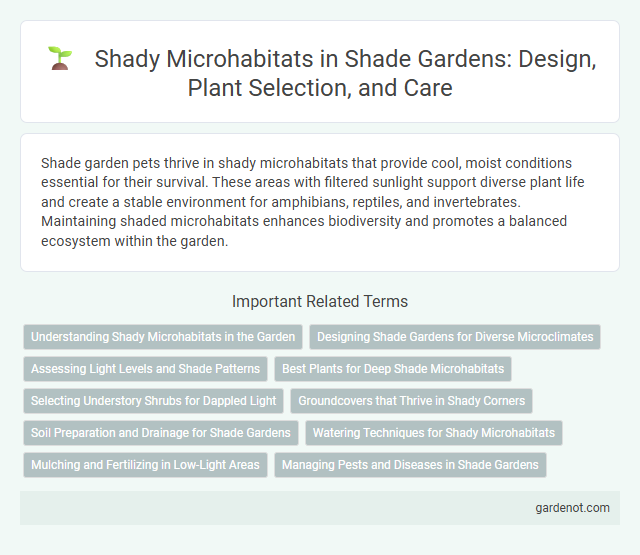Shade garden pets thrive in shady microhabitats that provide cool, moist conditions essential for their survival. These areas with filtered sunlight support diverse plant life and create a stable environment for amphibians, reptiles, and invertebrates. Maintaining shaded microhabitats enhances biodiversity and promotes a balanced ecosystem within the garden.
Understanding Shady Microhabitats in the Garden
Shady microhabitats in the garden create unique environments characterized by limited sunlight, higher humidity, and cooler temperatures, fostering the growth of shade-tolerant plants like ferns, hostas, and astilbes. These microhabitats support biodiversity by providing refuge for moisture-loving insects, amphibians, and ground-dwelling wildlife. Understanding soil moisture retention, light diffusion, and microclimate variations is essential for optimizing plant health and garden sustainability in shaded areas.
Designing Shade Gardens for Diverse Microclimates
Designing shade gardens requires careful consideration of shady microhabitats, where light levels range from deep shade to dappled sunlight. Selecting plants such as ferns, hostas, and astilbes that thrive in low-light, high-moisture conditions ensures successful growth across diverse microclimates. Incorporating layered vegetation structures and moisture-retentive soil improves microclimate stability, promoting plant health and biodiversity in shaded areas.
Assessing Light Levels and Shade Patterns
Assessing light levels and shade patterns in a shady microhabitat is crucial for successful shade garden design, as plants require specific light intensity and duration to thrive. Measuring natural light exposure throughout the day using tools like light meters helps identify areas of full, partial, or deep shade. Understanding shade patterns influenced by trees, structures, and seasonal changes enables optimal selection of shade-tolerant species and strategic plant placement.
Best Plants for Deep Shade Microhabitats
Hostas thrive in deep shade microhabitats due to their large, textured leaves that capture limited sunlight efficiently. Ferns, particularly the Japanese Painted Fern and Lady Fern, are well-adapted to low light conditions and add delicate foliage to shady gardens. Astilbes and Solomon's Seal also perform exceptionally in deep shade, providing colorful blooms and graceful arching stems that enhance the garden's depth and texture.
Selecting Understory Shrubs for Dappled Light
Understory shrubs such as Hydrangea quercifolia, Fatsia japonica, and Ribes sanguineum thrive in dappled light conditions, making them ideal for shade gardens. These shade-tolerant plants require well-drained soil with consistent moisture to maintain vibrant foliage and blooms. Selecting shrubs with varied leaf textures and seasonal interest enhances the layered effect characteristic of shady microhabitats.
Groundcovers that Thrive in Shady Corners
Groundcovers like Vinca minor, Pachysandra terminalis, and Lamium maculatum thrive in shady corners, providing lush, dense foliage while suppressing weeds and preventing soil erosion. These shade-tolerant plants adapt well to low light conditions and maintain vibrant greenery throughout the growing season. Incorporating native species such as Epimedium and Ajuga reptans enhances biodiversity and supports local ecosystems in shaded microhabitats.
Soil Preparation and Drainage for Shade Gardens
Soil preparation in shady microhabitats requires enriching the soil with organic matter to improve nutrient availability and moisture retention, essential for understory plants. Proper drainage is critical to prevent waterlogging, which can lead to root rot, so amending soil with compost or coarse sand enhances permeability in dense shade garden beds. Ensuring balanced soil pH and consistent moisture levels supports the growth of shade-tolerant species like hostas, ferns, and astilbes.
Watering Techniques for Shady Microhabitats
Shady microhabitats require consistent moisture retention due to reduced sunlight and slower soil drying. Employing drip irrigation or soaker hoses ensures deep, even watering while minimizing leaf wetness that can encourage fungal diseases. Mulching with organic materials helps conserve soil moisture and maintains a stable temperature ideal for shade-loving plants.
Mulching and Fertilizing in Low-Light Areas
Mulching in shady microhabitats retains soil moisture and regulates temperature, vital for plant health in low-light conditions. Organic mulches like shredded leaves or bark improve soil fertility as they decompose, supporting nutrient availability. Fertilizing with slow-release, balanced fertilizers ensures steady nutrient supply, enhancing growth where photosynthesis is limited by shade.
Managing Pests and Diseases in Shade Gardens
Managing pests and diseases in shade gardens requires selecting shade-tolerant plants that are naturally resistant to common pests such as slugs, aphids, and fungal pathogens like powdery mildew. Regular monitoring of plants for early signs of infestation and the use of organic treatments such as neem oil or insecticidal soap help maintain a healthy microhabitat. Improving air circulation through proper spacing and mulching with organic materials reduces moisture buildup, minimizing conditions favorable for disease development.
Shady microhabitat Infographic

 gardenot.com
gardenot.com